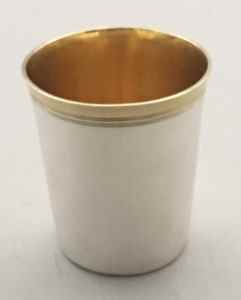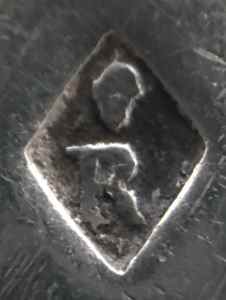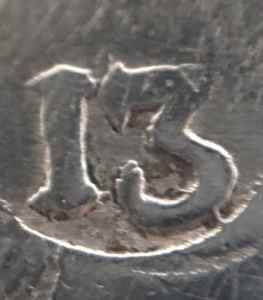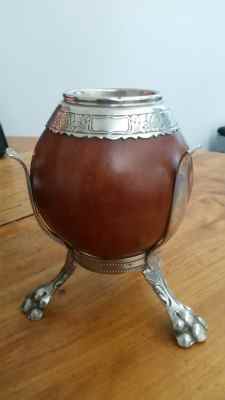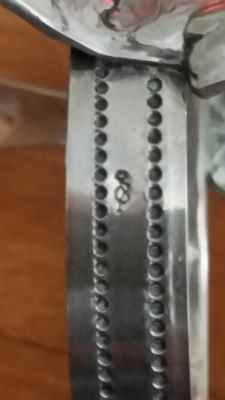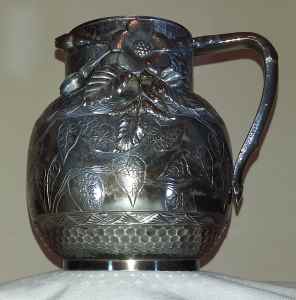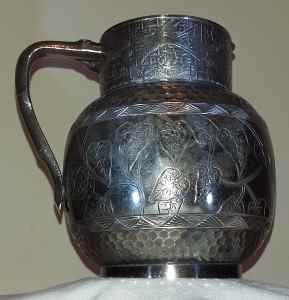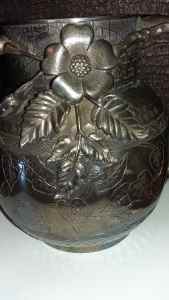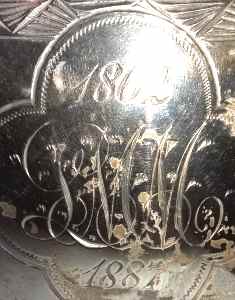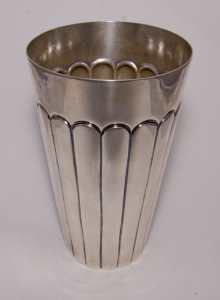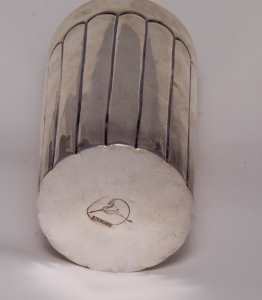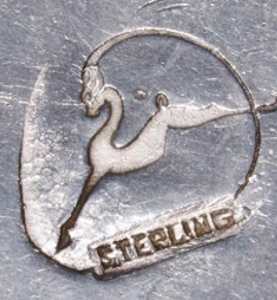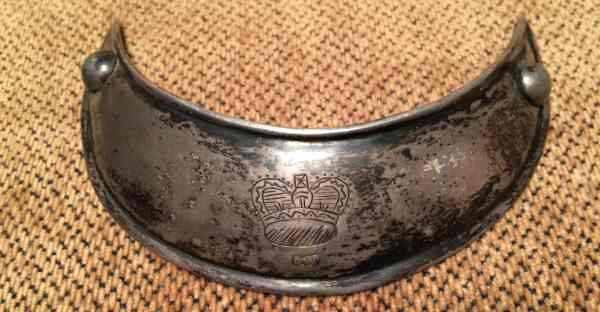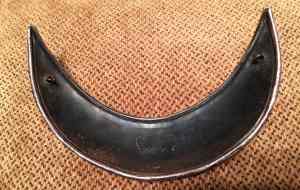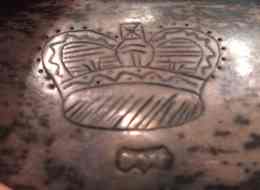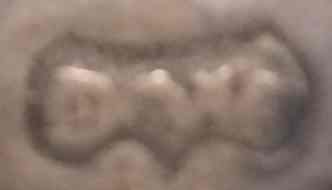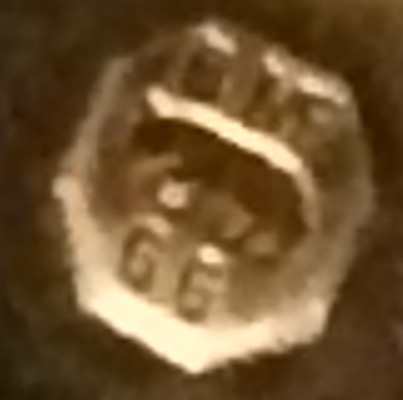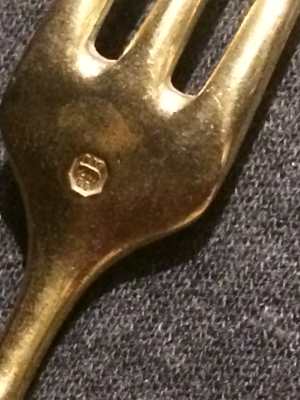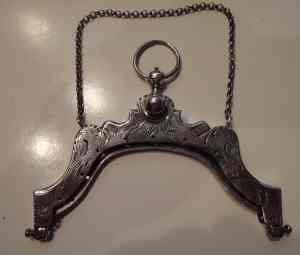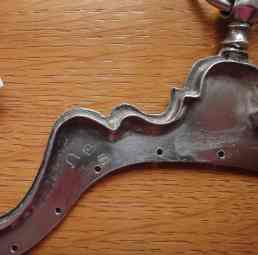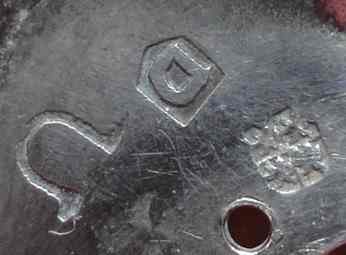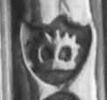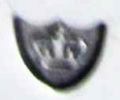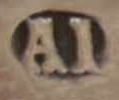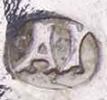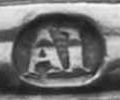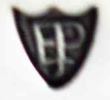YOUR GUIDE TO OCTOBER NEWSLETTER:
articles
new members
members' window
mail to ASCAS
replies to questions
a page per month
a silversmith per month
a word per month
a book on my shelf
a crest per month
contributors to this Newsletter
search engine
disclaimer and privacy policy
A new article for
ASCAS website

Wayne Bednersh presents:
Swiss Family Silver Genealogy Record

This set of 8 large serving spoons from the late 18th through the early 19th century chronicles one Swiss family's history.
It is not uncommon to find an occasional spoon engraved with names, initials and or dates, however finding a group of 8 spoons
for the same family is very rare. Despite extensive research I have not found anything comparable to this set.
Wedding and marriage customs vary significantly from culture to culture and from religion to religion and from province to province and tribe to tribe.
The custom of engraving the initials of the bride and groom and a date onto a valuable silver spoon was mainly central European but spoons so engraved have also been found in England, the USA and elsewhere.
Silver spoons were often chosen for important familial events because they not only represented 'real wealth' but were also a symbol of food consumption (one of the most important things that people were very concerned about in eras where the availability of food would often vary considerably from year to year).
For a newly married couple sharing a common meal made the spoon an obvious choice....
click here

New members
Welcome to new ASCAS members:
Antonia Brodie - England UK
Rodger Madison - USA
Reinhard Sänger - Germany
Members' Window

Dr. David N. Nikogosyan presents:
Marks of European Silver Plate: XIV: WMF - Marks of Hollow Ware and Trays

This month Dr. Nikogosyan presents the revised and updated version of his work dealing with WMF Hollow Ware and Trays marks.
Next month ASCAS will publish "WMF Cutlery & Napkin Rings Marks", a matter that, before Dr. Nikogosyan research, nobody tried to investigate and organize.
click here

Mail to ASCAS:
e-mail
silverassociation@yahoo.it
John Langford writes:
Following Birmingham & Sheffield Assay Offices' decision to use the same traditional UK hallmarks on items assayed in their Mumbai and Malpensa assay operations, a group of UK silversmiths and jewellers have launched a campaign to restrict the use of distinctive traditional UK hallmarks, including the City marks, to items actually hallmarked in the UK.
For 700 years UK hallmarks have only been struck in the UK, and has given an unequivocally guaranteed status to the gold and silver items it endorses. The testing carried out for assaying is rigorously supported by local councils through their trading standards departments and The Hallmarking Act 1973.
There is now a considerable drive by assay offices to set up offshore operations where items can be stamped with a UK hallmark without ever having been examined by an assay office in the UK. This is to give UK assay offices the opportunity to compete for trade across the world and allow manufacturers in places like India and China access to an assay mark that is recognised throughout the EU and in other major markets.
When such a change was initially considered - requiring a change to the hallmarking Act - it was unanimously agreed by all the assay offices and the UK Government that the assay marks applied to any item by such an off-shore assay office, reliant on the local trade ethos, legal framework and regulation of the host country, would be clearly differentiated from those applied by a UK office.
Indeed, all four UK offices designed specific marks to be used in offshore operations.
In January 2013 Viscount Younger of Leckie stated in the Lords while considering Legislative Reform (Hallmarking) Order 2013, "A feature of the scheme to permit offshore marking is that the British Hallmarking Council will authorise offshore-struck marks, which will be clearly distinguishable from the existing domestically struck marks. In order to make clear the distinction between the two sets of marks, the council will also issue guidance to the new off-shore marks. This will help introduce clarity to consumers, retailers and the enforcement community alike."
However, Birmingham Assay Office, which now has a branch based in Mumbai has authorised the anchor, a mark used on items assayed in Birmingham UK since 1773, to be used in Mumbai, alongside the other traditional UK fineness marks. In effect, striking marks in Mumbai identical to those in Birmingham.
This means that as from August 2016, those purchasing an item with a Birmingham assay mark, both consumers and retailers, will be unable to tell if the item was assayed in the UK or Mumbai, short of examination by an expert.
Many UK manufacturers are wondering why, when the government so clearly made assurances that a different mark was to be used for offshore assayed items, has the British Hallmarking Council allowed to happen? Marking items at an offshore assay office with the same assay marks used by a UK assay office is clearly against the will of parliament.
A recent survey of UK consumer understanding of hallmarks clearly illustrates a serious risk of 'passing off' as after 700 years of habituation the majority of consumers belief that a UK hallmark indicates that an item was assayed in the UK, by the assay office as indicated by the City mark.
There is also growing opposition amongst other European Assay organisations who believe that the offshore struck UK hallmark will be used to 'passport' items into EU markets from territories whose domestic hallmarking standards do not meet the required levels for acceptance into their market.
The group have just launched a website with more information and access to documents:
http://www.save-uk-hallmarking.co.uk/
A petition to Parliament:
https://petition.parliament.uk/petitions/162103
Results of a consumer survey:
https://www.surveymonkey.net/results/SM-7RHSTPNT/
Facebook page:
https://www.facebook.com/saveukhallmarking/
Maurice Meslans writes:
...I have collected silver from anywhere near the Alsace region for decades. Of course this usually means Strasbourg or Colmar, but I have picked up things over the borders like Deux Ponts, and Switzerland. I have also been surprised at the lack of published information on Alsatian silver, except Strasbourg. This is particularly odd as Strasbourg silver is so sought after. I have never even seen a list of 19th century Strasbourg silversmiths. Of course collectors know of Kirstein, Schuler, Buttner, Imlin, Fritz, and Raeuber, but even finding examples of their marks is difficult. I doubt a complete list of Ancien Régime Alsace silversmiths exists. From the royal ordinances of 1727, we know many of the smaller cities were allowed to have silversmiths. Colmar was allowed 6, Haguenau 4, and Neuf-Brisach, Belfort, Landau, Savernes and Wissembourg were allowed to have one each. Yet how many objects from these cities are known to still exist?
I recently ran across this beaker. I would say it is c. 1800, it is 8.5 cm high and weighs 3.9 troy oz. The interior and lip are gilt. The marks are rather unusual. The maker's mark is an R with what could be an acorn above it. The 13 mark is in an oval. Both are rather small for a piece of hollowware. The lozenge is 3.5 mm long and the oval of the 13 is 4 mm long. We all know the lozenge mark was introduced in France in 1797. Also in the Strasbourg at the end of the 18th century a 13 mark in an oval was used, but I have never seen an example. The 13/16 standard was used in France, Germany and other European countries. The lozenge maker's marks were primarily found in France although occasionally in western Germany especially in places under French influence during the Napoleonic period. If the symbol above the R is in fact an acorn it might be a rebus. An acorn in German is an "eichel" so R + eichel = Reichel. Reichel is a name found in Germany, but I could find no silversmith in the right time frame. Of course any suggestions are welcome.
Maurice Meslans
Alan Yates writes:
... Images attached of a mate cup in a silver stand. I bought it in Durban, South Africa in April earlier this year. A nice unmarked silver collar with a vacant cartouche. The stand is marked on the circular ring above the three feet, on the RHS of first image.
My guess would be Spanish Colonial but I cannot identify the mark. Could you or members assist?
Kind regards
Alan Yates
I have three books dealing with Spanish Colonial silver. All mate cups are unmarked. Most of them have a more elaborated decoration with animals and other symbols and stand on a plate.
Your cup is presumably Spanish Colonial but I don't believe that the "mark" will be sufficient for identification of origin and date.
I publish your question trusting in the assistance of ASCAS members.
By the way, I too have an unmarked mate cup in my collection, see my website at http://www.silvercollection.it/pagina229.html
Giorgio Busetto
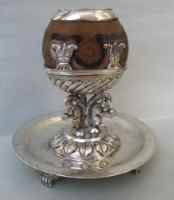
H. Howe writes:
... I have an old silver quadruple plate water carafe with an unknown mark at the bottom.
Please be so kind and help me to find out who is the silver manufacturer.
Many thanks in advance
H. Howe
The mark is unclear but I believe it's Derby Silver Co, see my website at http://www.silvercollection.it/AMERICANSILVERPLATEMARKSDE.html
The Company, founded in 1873, was one of the original firms forming International Silver Co in 1898. It was consolidated into Meriden in 1933
Giorgio Busetto
John Lee Montgomery writes:
... I am trying to identify an unusual, obscure, maker's mark. I have researched for many hours with no results.
The best information I have received is from a gentleman who was shown the same stamp on a Sterling tray twenty years ago.
As the story goes: a Veteran from WW2 showed this item and said it was from post WW2 (1944/45) when the Austrian people were producing items for the GI's because they were the only ones holding 'Hard Cash'.
This is the extent of my information right now.
John Lee Montgomery
Maurice Meslans writes
I thought perhaps you might want my opinion of the Gorget. This type of breast plate was an insignia worn by many types of European military officers. It was called a gorget in English and a gorgerette or hausse-col in French. Evidently the Amerindians liked the form, especially the French form, and soon the English, French and probably the Spanish were making them as "peace" gifts. The Americans also gave "peace" gifts but it was far more commonly used, like all other forms of silver ornaments, as trade goods. Many of these gifts were simply ordered by fur traders, to use in the trade. Of course the larger pieces like gorgets were probably given to important members of the tribes in order to insure or obtain permission for trade.
Unfortunately at least 50 years ago, the fakers started reproducing or more exactly faking examples. These fakes started arriving in private collections and eventually public collections. Originally the copies wouldn't fool anyone, but eventually the fakes became quite convincing. Since many of the original items were just produced by apprentices copying them can be quite easy. The marks however were harder to fake, as were well engraved examples. Decades ago a Winterthur curator told me they had tested many examples in many collections and had yet to find a real one. In one museum I inspected hundreds of fakes which they sent off to be tested, all were fake but by design or accident some were made from old metal. Another museum had two very rare examples obtained at least 50 years earlier, after I told the curator how rare they were, he promptly went out and bought another, again a fake. I have seen many obvious fakes illustrated as real, and have inspected more closely many fakes in major public collections. Most the real pieces found in archeological digs are small, unmarked, or made by a few of the major producers like Cruickshank, or Arnoldi.
The faker's quickly found it was easier to make up a mark, and call it "unattributed". Many of these marks were later attributed to some silversmith and found their way into books as real. My proof of the number of fakes is simple. I know of several silversmiths, who made a lot of trade silver, but because their marks are rare or un-published, no piece with appropriate marks has ever been discovered. Most trade goods were simply not marked. He says it was "recovered from a Creek Indian site". Unless this was a legitimate archeological site and no money changed hands, I would absolutely say it is fake. I know of at least one lot of fakes, decades ago, were the buyer was taken along to discover some of the fakes in a dig. This is a little akin to salting a gold mine. I am going to presume that it was "recovered" by the person who faked it. While I could not say for sure, from just pictures, there are a few characteristics which make it doubtful. The oddly shaped cartouche would be extremely rare in America, and while similar oddly shaped ones can be found in Canada, they would, with one exception be too late. The Crown is very crudely engraved and punched. Again since it was buried, the odds are it has no original patina. I would finally be extremely careful about buying any piece of silver trade goods, there are few real experts in the field, fakes are easily and cheaply produced, even cheaply enough to sell as reproductions, and the lack of recognizable patina is easily explained away as they were buried.
Maurice Meslans
Dr. David Nikogosyan writes
This is a mark of Arthur Krupp Berndorf factory in Austria for gilt cutlery.
"gg" means "ganze vergoldet", in English translation "entirely gilt".
This mark was used since 1912.
Regards,
David Nikogosyan
Peter van Oel writes
Silver purse handle with the town mark of Schoonhoven being a shield with four lion's rampant facing left; the guild city mark of Schoonhoven. Town mark without province mark for 2nd standard silver or Kleine keur, 83.3% pure silver used.
The year letter D for 1797.
Maker's mark U for: Jan van Millingen, born 1757, registered in 1782 as silversmith in Schoonhoven, died somewhere between 1807-1812.
Peter van Oel
"A PAGE per MONTH"
In this column we presents a page obtained from makers'
brochures, books, auction catalogs, advertising or whatever
other printed paper, related to silver, that may be of interest
for ASCAS members.
The images will be published at a "low resolution" level and for
private and personal use only.
This column is published under the kind permission of Giorgio
Busetto's website

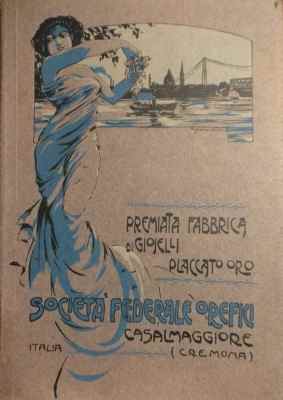 |
This month ASCAS presents an ancient advertisement of
FABBRICHE RIUNITE PLACCATO ORO
The firm was founded in 1926 in Casalmaggiore, Cremona, Italy, but the origin of the business date back at the end of the 19th century when Giulio Galluzzi
(1855-1932) started in his workshop the production of silver gilt objects and jewels marked "G.G", obtaining great success in Italy and abroad (specially Latin America) for their design and quality of gilding.
At the beginning of the 20th century Galluzzi transferred the production into a larger factory while the Casalmaggiore area became the district of silver gilding with the opening in 1906 of the Società Federale Orefici (by a group of skilled workers of Galluzzi's factory) and of the "Placcato Oro" factory (bought by Giuseppe Maffei in 1920).
After WWI the "bijoux" manufactured in Casalmaggiore district continued their worldwide success and in 1926 the major manufacturers (Federale, Galluzzi and Maffei) created the Società Anonima Fabbriche Riunite Placcato Oro with a labor force of over 500 workers.
After WWII, the manufacture of "bijoux" by the Fabbriche Industrie Riunite Spa (FIR), successor to the dissolved Società Anonima, was for some time supported by
the vogue of jewelry made of "poor" metal and non-precious stones emphasized by Hollywood stars and fashion stylists as Coco Chanel and Cartier but in 1970 the factory ceased its activity and the building was converted to other production.
From 1986, more than 20000 objects manufactured by Casalmaggiore factories are exhibited in the Museo del Bijou of Casalmaggiore.
Other images
|
"A WORD per MONTH"
In this column we
present an abstract from a page of the "What is? Silver Dictionary"
courtesy of


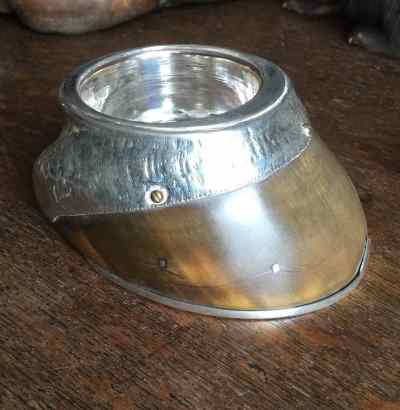 |
HORSE HOOF INKWELL
In the 19th century it was a common practice for British gentlemen to transform into an inkwell the hoof of their dead horse.
It was the simple way to remember the beloved companion of happy moments or to commemorate a horse races winner.
Often the inkwell was inscribed with name, age and victories of the horse.
Usually the metal framework of the inkwell was made by silversmiths or electroplaters, while the task of preparing, stuffing, and mounting the hoof could be reserved to taxidermists. The best known British taxidermist was James Rowland Ward (1848-1912), founder of Rowland Ward Ltd active in taxidermy until the 1970s..... MORE...
|
"A SILVERSMITH per MONTH"
|
|
LATHAM & MORTON
LATHAM & MORTON LTD
The partnership of Thomas Latham and Ernest Morton was established in 1866 in Birmingham.
Later they were joined in the partnership by Austin Edmund Latham and John Morton.
The firm was active at Pallas Works, 115/116 Vyse Street, Birmingham (1898-1901).
After the retirement of Thomas Latham (1904) the firm was converted into a limited liability company under the style of Latham & Morton Ltd....
more
|
"A CREST per MONTH"
GRADWELL
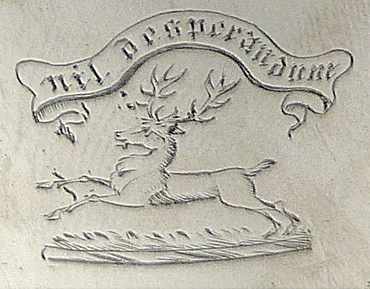
|
A stag, trippant
The Latin motto is 'Nil desperandum' (Never despairing)
The crest was found on a sterling silver teapot, hallmarked London 1790, maker Samuel Godbehere
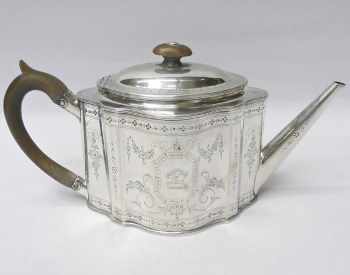
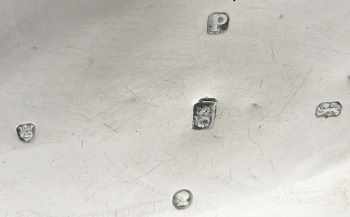
|
Closing our October 2016 edition of ASCAS Newsletter I hope
you have appreciated its content.
Your comments, suggestions and advice will be of great help.
My thanks to Wayne Bednersh, H. Howe, John Langford, Maurice Meslans, John Lee Montgomery, Dr. David N. Nikogosyan, Peter van Oel and Alan Yates for their precious contributions.
Giorgio Busetto
Secretary
DISCLAIMER AND PRIVACY POLICY
ASCAS is a community of people having a common
interest in antique silver.
It is a non-profit association without commercial links.
Membership is open to whomever has a true interest in
this subject matter.
ASCAS has no real property and no fees are requested nor
accepted from members.
ASCAS keeps in touch with its members only through
periodical newsletters, e-mails and web-site updating
and ignores and is not responsible for any other
activity pursued by its members.
Likewise, ASCAS is not responsible for opinions,
evaluation and images displayed, and in any form
published or supplied for publication, by its members
who, in any case, maintain the property of their works
and assure the respect of national and international
legislation about Intellectual Property.
ASCAS does not have the full addresses of its members (only
town, country and e-mail address are requested for
membership).
ASCAS handles and protects with care its members' e-mail
addresses, will not disclose the addresses to third
parties, will use this information only to reply to
requests received from members and for communications
strictly related to its activity.
These rules are expressly accepted by submitting the
membership request.
|
|
 newsletter
# 149 October 2016
newsletter
# 149 October 2016







